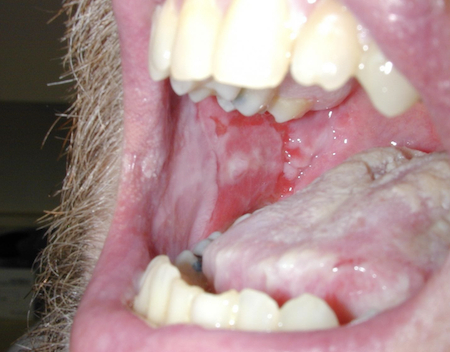Resumo
Definition
History and exam
Key diagnostic factors
- presença de fatores de risco
- formação de bolhas erosivas crônica da pele, mucosa ou ambas
- erosões crônicas da boca (pênfigo vulgar [PV], pênfigo paraneoplásico [PPN])
- lábios dolorosos (PPN)
- dispneia (PPN)
Other diagnostic factors
- couro cabeludo pruriginoso (PV, PF)
- epistaxe (PV, PPN)
- pele dolorosa (PV, PF, PPN)
- disfagia (PV)
- pele pruriginosa (PV, PF)
- conjuntivite (PV, PPN)
Risk factors
- idade mais avançada
- HLA DR4 (pênfigo vulgar [PV])
- HLA DQ1 (PV)
- HLA DRB1 (pênfigo paraneoplásico [PPN])
- neoplasia maligna subjacente (PPN)
- uso de penicilamina
- uso de IECAs
- uso de penicilina
- uso de tiopronina
- uso de interleucina-2
- uso de nifedipino
- uso de rifampicina
- exposição a insetos hematófagos
Diagnostic tests
1st tests to order
- biópsia de pele, coloração de hematoxilina e eosina
- biópsia de pele, imunofluorescência direta
Tests to consider
- imunofluorescência indireta em soro
- ensaio de imunoadsorção enzimática (ELISA) sérico
- endoscopia digestiva alta
- radiografia torácica
- tomografia do tórax
- testes de função pulmonar (TFPs)
- imunoblot sérico (Western Blot)
Treatment algorithm
pênfigo vulgar leve
pênfigo foliáceo leve
pênfigo vulgar ou pênfigo foliáceo moderado a grave
pênfigo paraneoplásico
pênfigo vulgar ou pênfigo foliáceo moderado a grave 6 meses após a terapia inicial: com controle da doença/remissão completa
pênfigo vulgar ou pênfigo foliáceo moderado a grave 6 meses após a terapia inicial: com remissão completa
pênfigo vulgar ou pênfigo foliáceo moderado a grave 12 a 18 meses após a terapia inicial: remissão completa
pênfigo grave/refratário
Contributors
Authors
Jon H. Meyerle, MD
Associate Professor
Department of Dermatology
Uniformed Services University of the Health Sciences
Bethesda
MD
Disclosures
JHM declares that he has no competing interests.
Grant J. Anhalt, MD
Professor
Department of Dermatology
Johns Hopkins Medical Institution
Baltimore
MD
Disclosures
GJA declares that he has no competing interests.
Peer reviewers
Daniel Mimouni, MD
Professor
Department of Dermatology
Rabin Medical Center
Petah Tikva
Israel
Disclosures
DM declares that he has no competing interests.
Vesna Petronic-Rosic, MD, MSc
Associate Professor and Clinical Director
Section of Dermatology
University of Chicago
Chicago
IL
Declarações
VPR declares that she has no competing interests.
Timothy Patton, MD
Assistant Professor of Dermatology
Department of Dermatology
University of Pittsburgh
Pittsburgh
PA
Declarações
TP declares that he has no competing interests.
Créditos aos pareceristas
Os tópicos do BMJ Best Practice são constantemente atualizados, seguindo os desenvolvimentos das evidências e das diretrizes. Os pareceristas aqui listados revisaram o conteúdo pelo menos uma vez durante a história do tópico.
Declarações
As afiliações e declarações dos pareceristas referem--se ao momento da revisão.
Referências
Principais artigos
Joly P, Horvath B, Patsatsi Α, et al. Updated S2K guidelines on the management of pemphigus vulgaris and foliaceus initiated by the european academy of dermatology and venereology (EADV). J Eur Acad Dermatol Venereol. 2020 Sep;34(9):1900-13.Texto completo Resumo
Antiga E, Bech R, Maglie R, et al. S2k guidelines on the management of paraneoplastic pemphigus/paraneoplastic autoimmune multiorgan syndrome initiated by the European Academy of Dermatology and Venereology (EADV). J Eur Acad Dermatol Venereol. 2023 Jun;37(6):1118-34.Texto completo Resumo
Murrell DF, Peña S, Joly P, et al. Diagnosis and management of pemphigus: recommendations of an international panel of experts. J Am Acad Dermatol. 2020 Mar;82(3):575-85.e1.Texto completo Resumo
Joly P, Maho-Vaillant M, Prost-Squarcioni C, et al. First-line rituximab combined with short-term prednisone versus prednisone alone for the treatment of pemphigus (Ritux 3): a prospective, multicentre, parallel-group, open-label randomised trial. Lancet. 2017 May 20;389(10083):2031-40. Resumo
Artigos de referência
Uma lista completa das fontes referenciadas neste tópico está disponível para os usuários com acesso total ao BMJ Best Practice.

Diagnósticos diferenciais
- Pênfigo benigno familiar (doença de Hailey-Hailey)
- Penfigoide bolhoso (PB)
- Dermatose linear bolhosa por imunoglobulina A (IgA)
Mais Diagnósticos diferenciaisDiretrizes
- Consensus based Indian guidelines for the management of pemphigus vulgaris and pemphigus foliaceous
- S2k guidelines on the management of paraneoplastic pemphigus/paraneoplastic autoimmune multiorgan syndrome initiated by the European Academy of Dermatology and Venereology (EADV)
Mais DiretrizesConectar-se ou assinar para acessar todo o BMJ Best Practice
O uso deste conteúdo está sujeito ao nosso aviso legal